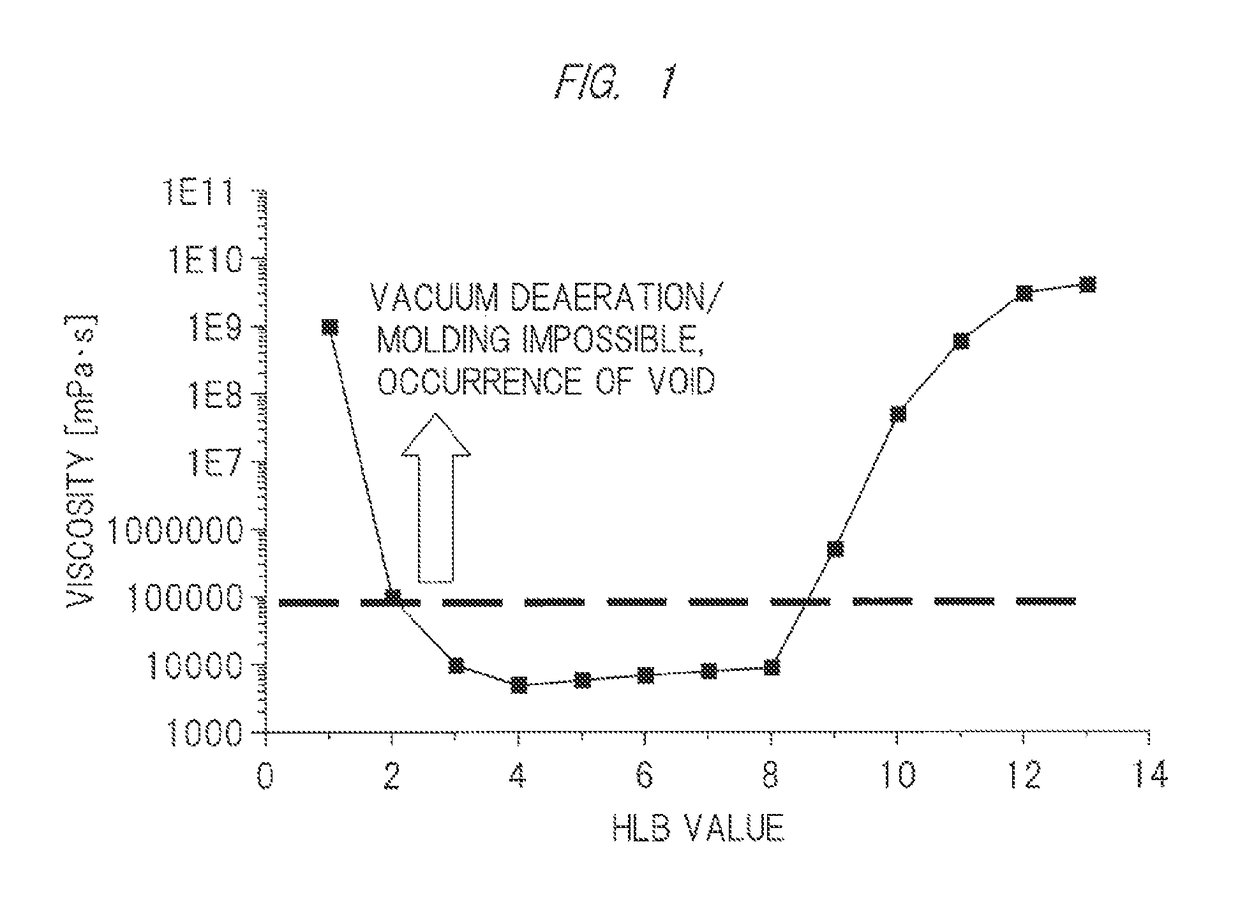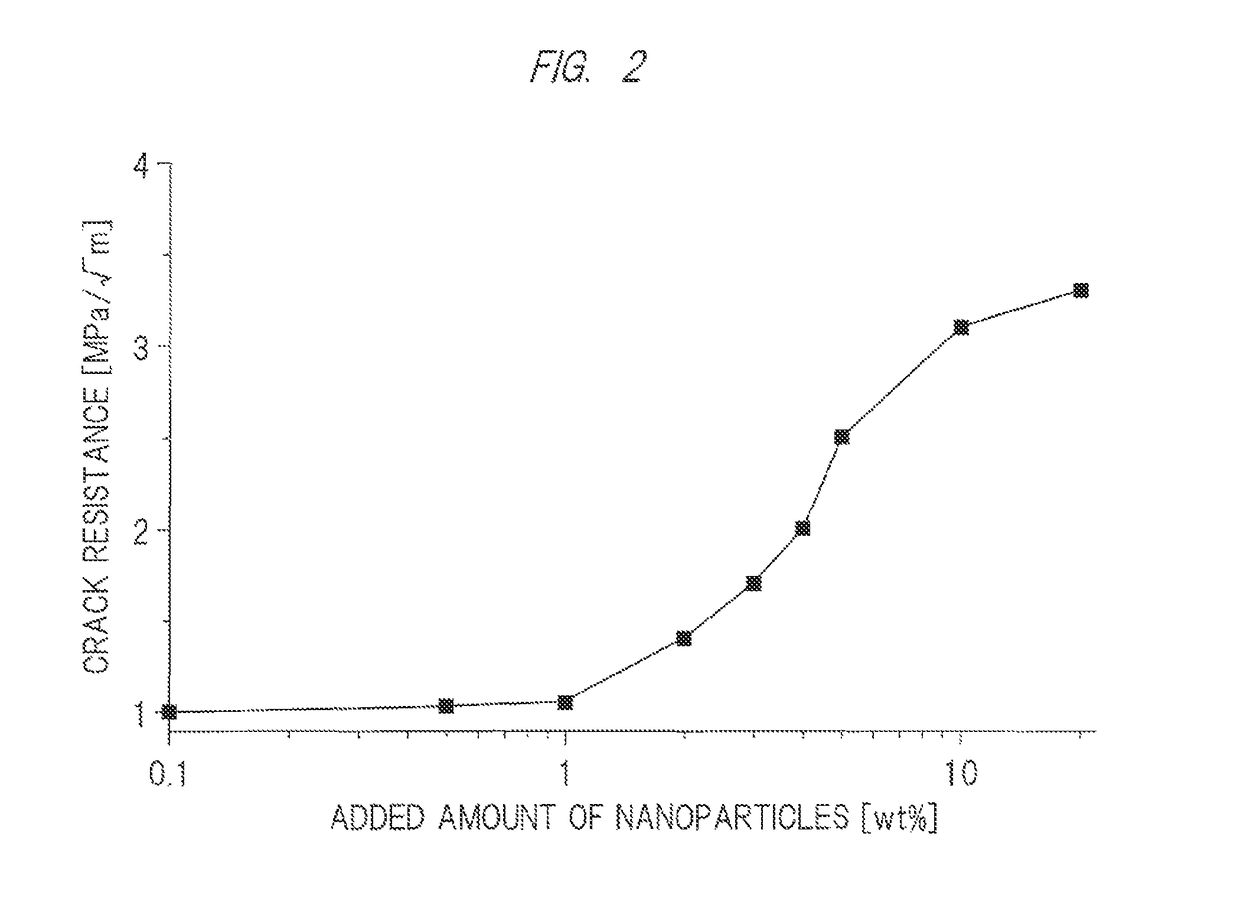Hybridized insulating resin material for high voltage equipment and high voltage equipment using the same
a technology of hybrid insulating resin and high voltage equipment, which is applied in the direction of rubber insulators, plastic/resin/waxes insulators, organic insulators, etc., can solve the problems of significant reduction in mechanical strength, loss of resin fluidity, and destruction of equipment, so as to improve the handling ability of resin, reduce the viscosity of resin, and increase the amount of fine particles
- Summary
- Abstract
- Description
- Claims
- Application Information
AI Technical Summary
Benefits of technology
Problems solved by technology
Method used
Image
Examples
example 1
[0058]In the example 1, as illustrated in FIG. 1, a relationship between the viscosity of the epoxy resin to which 20 wt % of the fine particles of 100 nm or less were added and the HLB value of the surfactant used for suppressing the viscosity was analyzed. The nonion surfactant added herein was polyoxyethylene phenyl alkyl ether. A typical structural formula thereof is shown below.
[0059]
[0060]The added amount of the surfactant was 0.25 wt %.
[0061]The HLB value of the polyoxyethylene phenyl alkyl ether was changed to 1 to 14 and the viscosity of the epoxy resins each containing the polyoxyethylene phenyl alkyl ether was measured by a viscometer.
[0062]As a result, as illustrated in FIG. 1, the viscosity thereof was 105 mPa·s or less in the range of the HLB value of 2 to 8. Thus, in the following experiment, polyoxyethylene phenyl alkyl ether having an HLB value of 8 was used.
[0063]Based on the examination mentioned above, 6 wt % of a nitrile butadiene rubber having an average partic...
example 2
[0066]In the example 2, a relationship between the added amount of nanofiller and a function was analyzed, and a lower limit and an upper limit of the added amount were obtained.
[0067]An experiment was performed on the added amount of the fine particles suitable for the present invention in the following manner. First, the added amount and the fracture toughness (crack resistance) of the resin to which elastomer particles of 100 nm or less were added were examined. As a result, as illustrated in FIG. 2, it was shown that when the added amount of the fine particles was 2 wt % or more, the crack resistance was enhanced as the added amount increased. Namely, it was shown that the lower limit of the added amount at which the function of the fine particles was exhibited was 2 wt %.
[0068]Furthermore, the upper limit of the added amount of the fine particles according to the present invention was examined from a relationship between the added amount of the fine particles and the viscosity ...
example 3
[0070]In the example 3, the particle size suitable for the fine particles according to the present invention was analyzed.
[0071]Specifically, a relationship between the particle diameter of the fine particles contained in the resin according to the present invention and the viscosity of the resin was examined. A concentration of the fine particles was set to 20 wt % with respect to the epoxy resin, and the viscosity thereof was measured while changing the diameter of the fine particles. FIG. 4 illustrates the result. From FIG. 4, it was shown that the viscosity of 105 mPa·s or more was obtained in the range of the particle size of 100 nm or less.
[0072]Therefore, it was shown that the particle size suitable for the fine particles according to the present invention was 100 nm or less.
PUM
| Property | Measurement | Unit |
|---|---|---|
| particle size | aaaaa | aaaaa |
| viscosity | aaaaa | aaaaa |
| particle sizes | aaaaa | aaaaa |
Abstract
Description
Claims
Application Information
 Login to View More
Login to View More - R&D
- Intellectual Property
- Life Sciences
- Materials
- Tech Scout
- Unparalleled Data Quality
- Higher Quality Content
- 60% Fewer Hallucinations
Browse by: Latest US Patents, China's latest patents, Technical Efficacy Thesaurus, Application Domain, Technology Topic, Popular Technical Reports.
© 2025 PatSnap. All rights reserved.Legal|Privacy policy|Modern Slavery Act Transparency Statement|Sitemap|About US| Contact US: help@patsnap.com



